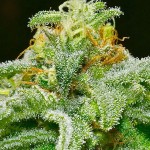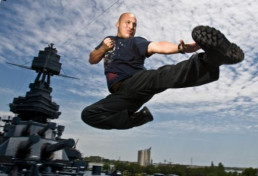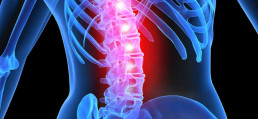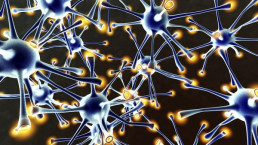Mother who uses Medical Marijuana faces 30 years in prison
Mother who uses Medical Marijuana faces 30 years in prison
Last week, the state of Kansas charged mother of two Shona Banda with five felony counts of possession of marijuana with the intent to distribute, manufacturing Tetrahydrocannabinol (THC), two counts of possession of drug paraphernalia and one count of child endangerment. These felony charges mean that Banda could face up to 30 years in prison.
And why has she been charged? Because she uses marijuana to help her debilitating Crohn’s Disease.
Earlier this year, Banda’s 11-year old son was taken from her by child protection services as her use of marijuana was deemed to have put the child in danger. Now the young mother, will be forced to turn herself in and could face up to 3 decades in jail.
Sarah Swain, a Kansas attorney who is representing Banda in her case stated to the press;
“These mothers are being forced to choose between their health and their ability to be a parent. And there really is no choice to be made. We can’t be mothers if we’re so sick that we’re bedridden, or if we aren’t alive.”
Banda has tried 17 prescriptive medications to combat her illness. Doctors told her that these drugs would “ease her passing”, expecting her to die. However, she has stated that since using medical marijuana, her health has taken a significant turn for the better, allowing her to be a more active mother for her children. Now, the only medicine that Banda believes is working for her, is to be taken away from her, along with her child and (potentially) her freedom.
Below are Kansas State Laws for the Possession, Sale and Cultivation of Marijuana:
Cannabis Oil Helps Hollywood Stuntman Overcome Stage IV Cancer
Cannabis Oil Helps Hollywood Stuntman Overcome Stage IV Cancer
In another high profile story regarding the success of medical marijuana, a Hollywood Stuntman has revealed that cannabis oil cured his stage 4 cancer.
Mark Chavarria had advanced cancer that had spread from his colon to his liver and, after researching many other documented cases, decided to use cannabis oil alongside radiotherapy and chemotherapy treatments.
Speaking to the media, Chavarria said,
“It’s kind of gross, but I literally felt like I was pooing the thing out every time I went to the toilet.
What I believe happens with the oil is it makes like a shellac on the tumors, and it doesn’t let it grow; doesn’t let it breathe; doesn’t let it eat… nothing. I think it was slowly, but surely, peeling away at the tumors like an onion.’
I feel good. I’m always nervous, always scared it will come back. But it’s gone. If it does come back, I know it won’t be as aggressive as last time because we’ll catch it early.”
76% of International Doctors Approve the use of Medical Marijuana
76% of International Doctors Approve the use of Medical Marijuana
In a ground-breaking survey by the New England Journal of Medicine, 76% of Doctors would approve the use of medical marijuana, according to CBS News.
The survey asked 1,446 doctors from 72 countries whether they would prescribe a patient medical marijuana in a hypothetical situation.
The circumstances that the doctors were faced with were as follows:
Marilyn is a 68-year-old woman with breast cancer that has metastasized to her lungs, chest cavity and spine. Would you give her medical marijuana to help her with her symptoms?
The overwhelming response in favour of medical marijuana in the survey was usually attributed to two key factors by the participants:
– Firstly, a knowledge of personal cases where marijuana was able to help patients.
– Secondly, their patients’ personal choice and the known dangers of prescription narcotics and painkillers.
This survey is one of the most exciting for medical marijuana activists, who believe that healthcare professionals supporting the use of medical marijuana is the key to an eventual global legalisation. However, many more doctors need to actively support the cause in order for any legalisation process to be taken seriously. And while the survey is certainly a step in the right direction, the requested anonymity of most of the participants means that this data may be disregarded by the ruling parties.
Alexis Bortell, 9, now 33 days Seizure free after using Cannabis Oil
Alexis Bortell, 9, now 33 days Seizure free after using Cannabis Oil
9-year-old Texan Alexis Bortell has now been seizure free for 33 days, after moving to Colorado to gain access to cannabis oil.
Bortell, who used to have dozens of seizures every day, but after switching from using pharmaceuticals to cannabis oil, her symptoms have halted completely.
Speaking to the media, Bortell’s father Dean stated, “We thought if we could get down to one ‘episode’ a week it would be a miracle. This week marks four weeks and zero symptoms. We are completely amazed.”
The Bortell family had hoped to return to Texas after the state legalized cannabis oil for epilepsy patients earlier this week. However, the strict regulations of the bill mean that Alexis would have to switch to a more CBD rich oil, something that the family are not willing to risk given their current success.
For now, the family will remain in Colorado as medical marijuana “refugees”, in order to continue the incredible success of their daughters new medicine.
CBD Spray Helps 9-Year-Old with Autism Speak his First Words
CBD Spray Helps 9-Year-Old with Autism Speak his First Words
A 9-year old Puerto Rican boy suffering with non-verbal Autism has spoken his first words, after using a CBD oromucasol spray.
Kalel Santiago was diagnosed with Autism 6 years ago after being given the all clear from a Cancer diagnosis. His parents were informed that it was unlikely they would ever hear their sons voice.
However, after two days of using a CBD spray, Kalel was began to recite his vowels in school.
Kalel’s father Abiel said to the media, “You can’t imagine the emotion we had, hearing Kalel’s voice for the first time. It was amazing. The teacher recorded him and sent it to my wife and me, and we said, ‘well, the only different thing we have been doing is using the CBD’.”
5 Studies that show Cannabis can help treat Parkinson's
5 Studies that show Cannabis can help treat Parkinson’s
One of the most common and perhaps heartbreaking degenerative disorders in the world today, Parkinson’s Disease is a disorder of the central nervous system as a result of the death of dopamine generating cells in regions of the brain.
One of the reasons as to why Parkinson’s is considered such a selfish, agonising disease may be down to its lack of answers. There is no known reason as to why the cells degenerate and no definitive cure to the disease itself.
However, despite its relentless nature as a degenerative disease, there are ways in which the side effects of Parkinson’s can be managed. Over the past 30 years, research into the medicinal benefits of marijuana on Parkinson’s have provided some fascinating conclusions:
1. In 2004, 339 patients attending the Prague Movement Disorder Centre were given a survey regarding cannabis use. 25% of respondents had used cannabis in order to combat their disease. Of these 25%, 45.9% noted that cannabis use had assisted with significant improvements in their condition.
2. In 2001, the Department of Neurology at Royal Manchester Infirmary, UK, revealed that the use of synthetic cannabinoid nabilone significantly reduced Dyskinesia in all 7 tested Parkinson’s patients. Dyskinesia is an involuntary muscle movement disorder that is often a symptom of Parkinson’s.
3. In one of the earliest studies of its kind, a 1985 report in the Journal of Neuroscience explained how CBD can reduce Dystonia and Dyskinesia symptoms in a Parkinson’s patient. The patient, a 42-year- old man with an 8-year history of parkinsonism, suffered with peak-dose dyskinesia and action dystonia. Prescription drugs Trihexyphenidyl and bromocriptine were given to the patient initially; with each producing only slight improvement. To stable optimal dosages of the three drugs, CBD was added. Once given CBD orally, there was a decrease in clinical fluctuations and in dyskinesia scores (by 30%) without a significant worsening of the parkinsonism.
4. Another study by the Journal of Neuroscience in 1986 evaluated the effect of CBD in dystonic movement disorders. CBD was given to 5 patients orally, alongside their already prescribed medicine. In all 5 tested subjects, an improvement of 20 to 50% in their dystonic symptoms was noted.
5. In 1998, the Journal of Movement Disorders published a study regarding the effect of nabilone on Parkinson’s patients suffering with Dyskinesia. In 7 studied patients, nabilone proved more effective than prescription drugs using the Goetz scale. 2 of the patients were noted as having vast improvements in their symptoms after using nabilone.
 |
 |
 |
 |
| Read Parkinsons Treatment Diaries | Discuss Parkinsons on our Forum | Read more on our Parkinsons Page | Find Top Parkinsons Strains |
Texas Legalizes Cannabis Oil For Epilepsy
Texas Legalizes Cannabis Oil For Epilepsy
Despite being one of the most staunch anti-cannabis States of America, Texas made a significant step this week by legalizing cannabis oil for epilepsy patients.
Governor Greg Abbott signed the bill on the 1st June, bringing Texas, for the first time, in line with many other states, who permit varying amounts of cannabis use.
While the bill may be a momentous moment for a state like Texas, which has extremely strict drug laws, there are still significant restrictions that many deem unacceptable. Only very small amounts of cannabis extracts may be used as treatment and the patients epilepsy must be deemed “severe” by a medical professional before the marijuana is prescribed.
Despite concerns as to the restrictions of the bill, Heather Fazio, Texas political director for Marijuana Policy Project, still believes that it is an historic moment for the state;
While this program leaves most patients behind and we’re concerned about its functionality, today is one for the history books. The Texas Legislature is sending a resounding message: Marijuana is medicine. We commend our Texas lawmakers and look forward to continuing this conversation when the 85th Legislature convenes in 2017.
5 Studies that show Cannabis can treat Spinal Cord Injuries
5 Studies that show Cannabis can treat Spinal Cord Injuries
Spinal cord injuries can result in some of the most damaging and unbearable side effects possible. Injuries in this area of the body often result in a change, either temporary or permanent to normal motor or sensory function.
A fragile, spaghetti-like plethora of nerves surround the spinal cord, all of which are vital to the human body functioning regularly. When these nerves are compromised, pain, spasticity, depression and many other side effects often occur, leaving the victim in constant need for medical treatment.
Recent studies have indicated that perhaps the most effective treatment for Spinal Cord Injuries and its related side effects is medical marijuana.
1. In a 2010 study, the Department of Medicine at the University of Manitoba, Canada recruited 12 volunteers with spinal injuries to test whether Nabilone, a synthetic cannabinoid alleviated their spasticity. The results concluded that 11 of the 12 subjects showed significant decrease in activity from affected muscle groups.
2. The Switzerland Centre for Spinal Cord Injury conducted a study in 2007 involving 25 patients with spinal cord related injuries. Each subject was given oral THC in the form of oil. By the end of the study a major overall decrease in the spasticity sum score (SSS) was noted through this method of treatment, leading the centre to conclude that THC is an effective and safe drug in the treatment of spasticty.
3. In 1995 the Medical College of Georgia, Augusta, conducted a test on five quadriplegic patients using Dronabinol as treatment. At the conclusion of the test, Spasticity was markedly improved in two of the five patients, while two showed slight improvements and one showed no improvement. In all five subjects however, decreased vigour in erratic mood states was noted.
4. A 1982 study conducted by J. Malec and RF Harvey compiled 43 questionnaires from cannabis users who suffered from severe spinal cord injuries. The results showed that all 43 participants reported decreased spasticity with cannabis use.
5. In 2001, the Switzerland Centre for Spinal Cord Injury conducted a study on SCI sufferers who all experienced overactive bladder as a major side effect. 15 patients were given THC orally or rectally over a period of 6 weeks. At the end of the study, the oral group did not demonstrate much of a reduction in bladder activity. However, the rectal group showed significant decreases in bladder activity, with 5 of the 6 measuring “tools” indicating improvement in all rectally treated patients.
First 'Cannabis Pharmacy' opens in the U.K.
First ‘Cannabis Pharmacy’ opens in the U.K.
A Czech entrepreneur has opened the first ever cannabis pharmacy in London, in a groundbreaking move for the country.
Michael Takac has opened Carun in Twickenham, which will sell hemp based products that are exclusive to the pharmacy.
After losing three of his fingers in an accident nearly a decade ago, Takac started using hemp ointment for the pain and found it to be the only effective treatment long term.
Despite being called a pharmacy, Takac stated that their will be no prescription medicine available.
More to Follow.
How Cannabis works with Dystonia
How Cannabis works with Dystonia
Dystonia is a rare, barely understood neurological movement disorder. It can be caused by physical trauma, particularly to the brain, as well as by certain classes of drugs, known as antipsychotics, used to treat certain kinds of severe mental illness. Other neurological conditions, such as Parkinson’s, which cause brain deterioration, can also create what are called “dystonic effects,” – also known as extreme rigidity of muscles.
There were almost no formal studies about the impact of medical marijuana on Dystonia before 2000, and as of now, there are very few published academic or medical reports that either users or their caregivers can access easily. Furthermore, conventionally used, widely administered drugs to treat the condition, including Baclafen, as well as Botox injections, often do not work, are highly expensive, and many patients report severe allergic reactions to the same.
That is the bad news. The good news is that medical marijuana (with the THC attached) works, like a dream, for many if not most Dystonia patients, if they can get it. It is perhaps the most effective and therefore important pharmacological tool available for managing the condition in any effective, long term manner.
Dystonia is characterized not only by constant spasming and contorting muscles, but also neuropathic pain that accompanies the same. It can appear in just about any extremity, including hands. Painful and disabling dystonias can occur in the neck, shoulder and facial areas – preventing those who suffer untreated of the ability to walk, speak or move. Medical pot cannot “cure” this condition or its downside effects. That said, in many cases, it can almost completely remove the pain, and in many cases, literally cause the muscles themselves to relax and unclench to the point that even severely disabled patients are able to move and function normally.
Finding doctors who are informed enough about this condition, not to mention who will help desperate patients obtain the drug in the UK is not an easy task. The best thing to do is contact a legal cannabinoid maker (such as GW Pharmaceuticals) and try to obtain Sativex – the mouth spray made from the whole cannabis plant. Marinol, a generic drug made from synthetic THC also works but it is hard to find and expensive in the UK. CBD seems to provide some relief from some of the muscle spasming that is characteristic of the condition, although not as much as when combined with high levels of THC. CBD also does not provide relief from the pain that still seems to be residual in many patients after treatment with cannabinoids that exclude THC.











